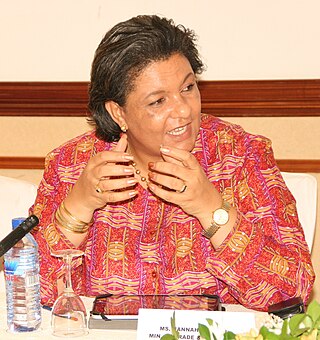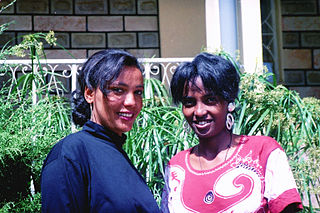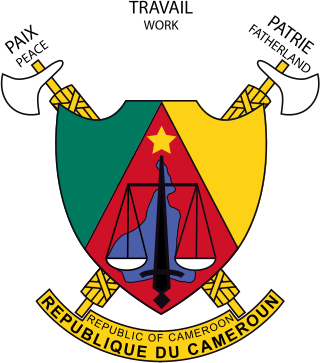Related Research Articles

Female genital mutilation (FGM) is the cutting or removal of some or all of the vulva for non-medical reasons. FGM prevalence varies worldwide, but is majorly present in some countries of Africa, Asia and Middle East, and within their diasporas. As of 2024, UNICEF estimates that worldwide 230 million girls and women had been subjected to one or more types of FGM.

A child (pl. children) is a human being between the stages of birth and puberty, or between the developmental period of infancy and puberty. The term may also refer to an unborn human being. In English-speaking countries, the legal definition of child generally refers to a minor, in this case as a person younger than the local age of majority, regardless of their physical, mental and sexual development as biological adults. Children generally have fewer rights and responsibilities than adults. They are generally classed as unable to make serious decisions.
Marriageable age, marriage age, or the age of marriage is the general age, a legal age or the minimum age marriage. Age and other prerequisites to marriage vary between jurisdictions, but in the vast majority of jurisdictions, the marriage age as a right is set at the age of majority. Nevertheless, most jurisdictions allow marriage at a younger age with parental or judicial approval, especially if the female is pregnant. Among most indigenous cultures, people marry at fifteen, the age of sexual maturity for both the male and the female. In industrialized cultures, the age of marriage is most commonly 18 years old, but there are variations, and the marriageable age should not be confused with the age of majority or the age of consent, though they may be the same.
Child marriage is a marriage or domestic partnership, formal or informal, usually between a child and an adult, but can also be between a child and another child.

Premarital sex is sex before marriage. Premarital sex is sex between two people who are not married to each other. Premarital sex is considered a sin by a number of religions and also considered a moral issue which is taboo in many cultures. Since the Sexual Revolution of the 1960s, it has become accepted by certain liberal movements, especially in Western countries. A 2014 Pew study on global morality found that premarital sex was considered particularly unacceptable in "Muslim Majority Countries", such as Malaysia, Jordan and Pakistan, each having over 90% disapproval, while people in Western European countries were the most accepting, with Spain, Germany, and France expressing less than 10% disapproval.
Family values, sometimes referred to as familial values, are traditional or cultural values that pertain to the family's structure, function, roles, beliefs, attitudes, and ideals. Additionally, the concept of family values may be understood as a reflection of the degree to which familial relationships are valued within an individual's life.

Child abuse is physical, sexual, emotional and/or psychological maltreatment or neglect of a child, especially by a parent or a caregiver. Child abuse may include any act or failure to act by a parent or a caregiver that results in actual or potential wrongful harm to a child and can occur in a child's home, or in organizations, schools, or communities the child interacts with.
Founded in 1800, the Kom are one of the 250 ethnic groups that are located in the grasslands of Cameroon within the Boyo Division of Africa. Kom includes most of Boyo division, including such towns as Fundong, Belo, Njinikom and Mbingo. The area can be reached from Bamenda on the so-called Ring Road.
Breast ironing, also known as breast flattening, is the pounding and massaging of a pubescent girl's breasts, using hard or heated objects, to try to make them stop developing or disappear. The practice is typically performed by a close female figure to the victim, traditionally fulfilled by a mother, grandmother, aunt, or female guardian who will say she is trying to protect the girl from sexual harassment and rape, to prevent early pregnancy that would tarnish the family name, to prevent the spread of sexually transmitted infections such as HIV/AIDS, or to allow the girl to pursue education rather than be forced into early marriage.

The status of women in Ghana and their roles in Ghanaian society has changed over the past few decades. There has been a slow increase in the political participation of Ghanaian women throughout history. Women are given equal rights under the Constitution of Ghana, yet disparities in education, employment, and health for women remain prevalent. Additionally, women have much less access to resources than men in Ghana do. Ghanaian women in rural and urban areas face slightly different challenges. Throughout Ghana, female-headed households are increasing.

There have been several studies concerning women in Ethiopia. Historically, elite and powerful women in Ethiopia have been visible as administrators and warriors. This never translated into any benefit to improve the rights of women, but it had meant that women could inherit and own property and act as advisors on important communal and tribal matters. As late as the first part of the 20th century, Queen Menen, consort of Emperor Haile Selassie I, had a decisive role in running the Ethiopian Empire. Workit and Mestayit regents to their minor sons have been held responsible for their provinces. They owed their rights to landed property because of a special type of land tenure that expected tenants to serve as militia to overlords, irrespective of gender. In 1896, Empress Tayetu Betul, wife of Emperor Menelik II, actively advised the government and participated in defending the country from Italian invasion. Prominent and other landowning women fought against the second invasion in 1935–41. With the assistance of European advisors, women in the ensuing period were kept out of the army and politics, even as advisors. Instead, they were restricted to family and household work of raising children and cooking. With a steady increase in female representation in education, they have started to undertake nursing, teaching, and other similarly supportive roles. Over the 2018–2019 period, their gradual participation in state politics has been increasing at a steady pace.

Women in the Democratic Republic of the Congo have not attained a position of full equality with men, with their struggle continuing to this day. Although the Mobutu regime paid lip service to the important role of women in society, and although women enjoy some legal rights, custom and legal constraints still limit their opportunities.

Women in Nigeria are a diverse group of individuals who have a wide range of experiences and backgrounds. They are mothers, daughters, sisters, wives, entrepreneurs, professionals, and activists. Women in Nigeria face numerous challenges, including gender inequality, poverty, and a lack of access to education and healthcare. Despite these challenges, Nigerian women are making strides in all areas of life and are becoming increasingly empowered to take control of their lives and their futures.

Women in Uganda have substantial economic and social responsibilities throughout Uganda's many traditional societies. Ugandan women come from a range of economic and educational backgrounds. Despite economic and social progress throughout the country, domestic violence and sexual assault remain prevalent issues in Uganda. Illiteracy is directly correlated to increased level of domestic violence. This is mainly because household members can not make proper decisions that directly affect their future plans. Government reports suggest rising levels of domestic violence toward women that are directly attributable to poverty.
Female foeticide in India is the abortion of a female foetus outside of legal methods. A research by Pew Research Center based on Union government data indicates foeticide of at least 9 million females in the years 2000–2019. The research found that 86.7% of these foeticides were by Hindus, followed by Sikhs with 4.9%, and Muslims with 6.6%. The research also indicated an overall decline in preference for sons in the time period.
Female child labour in Nigeria refers to the high incidence in Nigeria of girls aged 5–14 who are involved in economic activities outside education and leisure. The prevalence of female child labour in Nigeria is largely due to household economic status, but other factors include: the educational status of parents, the presence of peer pressure, and high societal demand for domestic help and sex workers. Additionally, in many rural and Muslim communities in Northern Nigeria, children are sometimes asked to aid religiously secluded women or mothers in running errands.

In the United States, a child marriage is a marriage in which at least one party is under 18 years of age—or the age of majority. It is the only UN member state that has not yet ratified the Convention on the Rights of the Child. Its Committee on the Rights of the Child "reaffirms that the minimum age limit should be 18 years for marriage."

Child marriage is a marriage or union between a child under the age of 18 to another child or to an adult. Child marriage is common in a multitude of African countries. In South Sudan, child marriage is a growing epidemic. Child marriage in South Sudan is driven by socioeconomic factors such as poverty and gender inequality. Current figures state that South Sudan is one of the leading countries in the world when it comes to child marriage. Child marriage has negative consequences for children, including health problems and lower education rates for South Sudanese girls. Many initiatives have been taken to combat child marriage in South Sudan, but the presence of societal norms and instability continues to drive its presence in the nation.
Child marriage in the Democratic Republic of the Congo is the eighteenth highest in the world. In a child marriage, one or both parties are under the age of eighteen years old. In the Democratic Republic of the Congo (DRC), 37% of girls are married before they turn eighteen, and 10% of girls are married before age fifteen. Though significantly less than the rate of child marriage for girls, 6% of boys in the DRC are married before age eighteen.

Cameroonian nationality law is regulated by the Constitution of Cameroon, as amended; the Nationality Code of Cameroon, and its revisions; and various international agreements to which the country is a signatory. These laws determine who is, or is eligible to be, a national of Cameroon. The legal means to acquire nationality, formal legal membership in a nation, differ from the domestic relationship of rights and obligations between a national and the nation, known as citizenship. Cameroonian nationality is typically obtained under the principle of jus sanguinis, i.e. by birth in Cameroon or abroad to parents with Cameroonian nationality. It can be granted to persons with an affiliation to the country, or to a permanent resident who has lived in the country for a given period of time through naturalization.
References
- ↑ "Child marriage around the world: CAMEROON", Girls Not Brides
- 1 2 Cislaghi, Beniamino; Mackie, Gerry; Nkwi, Paul; Shakya, Holly (3 October 2019). "Social norms and child marriage in Cameroon: An application of the theory of normative spectrum". Global Public Health. 14 (10): 1479–1494. doi: 10.1080/17441692.2019.1594331 . PMID 30895892. S2CID 84842161.
- 1 2 3 Cislaghi, Beniamino; Nkwi, Paul; Mackie, Gerry; Shakya, Holly (April 2020). "Why context matters for social norms interventions: The case of child marriage in Cameroon". Global Public Health. 15 (4): 532–543. doi:10.1080/17441692.2019.1704818. PMID 31880203. S2CID 209489819.
- ↑ Wetheridge, Louise (30 October 2014). "Child Marriage in West Africa and Cameroon: A Desk Review" (PDF). Plan WARO.
- 1 2 "Cameroon working on legislation to end child marriage". Xinhua News Agency. 28 November 2019. ProQuest 2319199155.
- ↑ "Pope Francis calls for inter-religious dialogue at open-air mass". France 24. 2015-11-26. Retrieved 2024-10-27.
- 1 2 Linonge-Fontebo, Helen Namondo (2018). "Socio-cultural, economical and organisational determinants of child marriage in Cameroon". In Green, M. Christian; Gunn, T. Jeremy; Hill, Mark (eds.). Religion, Law and Security in Africa. Vol. 5. African Sun Media. pp. 351–366. doi:10.2307/j.ctv21ptz2w.27. ISBN 978-1-928314-42-4. JSTOR j.ctv21ptz2w.27.
- 1 2 3 4 Green, Christian (2018). Religion, Law and Security in Africa. African Sun Media. pp. 351–366.
- ↑ Maswikwa, Belinda; Richter, Linda; Kaufman, Jay; Nandi, Arijit (June 2015). "Minimum Marriage Age Laws and the Prevalence of Child Marriage and Adolescent Birth: Evidence from Sub-Saharan Africa". International Perspectives on Sexual and Reproductive Health. 41 (2): 58–68. doi:10.1363/4105815. PMID 26308258.
- ↑ "Child Marriage Worries Rise Amid Coronavirus Lockdown in Cameroon". The New Humanitarian. June 11, 2020.
- ↑ Chishugi, John; Franke, Trixy (August 2016). "Sexual Abuse in Cameroon: A Four-Year-Old Girl Victim of Rape in Buea Case Study". Journal of Child Sexual Abuse. 25 (6): 619–626. doi:10.1080/10538712.2016.1194355. PMID 27561118. S2CID 205715174.
- ↑ Walker-Said, Charlotte (November 2017). "Christian Marriage between Tradition and Modernity: Catholic and Protestant Women and Marriage Education in Late Colonial Cameroon, 1939-1960: Catholic and Protestant Women and Marriage Education in Late Colonial Cameroon". Gender & History. 29 (3): 544–569. doi:10.1111/1468-0424.12317. S2CID 149179262.
- ↑ Koski, Alissa; Strumpf, Erin C.; Kaufman, Jay S.; Frank, John; Heymann, Jody; Nandi, Arijit (2018-05-24). Swadener, Beth Blue (ed.). "The impact of eliminating primary school tuition fees on child marriage in sub-Saharan Africa: A quasi-experimental evaluation of policy changes in 8 countries". PLOS ONE. 13 (5): e0197928. Bibcode:2018PLoSO..1397928K. doi: 10.1371/journal.pone.0197928 . ISSN 1932-6203. PMC 5967724 . PMID 29795648.
- ↑ Amin, Sajeda; Lynch, Andrea (2011). "When girls' lives matter: Ending forced and early marriage in Cameroon". doi: 10.31899/pgy3.1019 . Gale A263786324.
{{cite journal}}: Cite journal requires|journal=(help)
